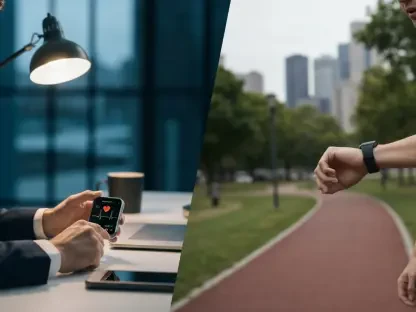Google is reportedly developing a new feature for Android devices aimed at reducing motion sickness, a common issue for many users during commutes or long journeys. This feature, tentatively named Motion Cues, was discovered through strings in the Google Play Services beta update v24.46.30 by Android Authority. The initiative follows Apple’s lead, which introduced a similar feature called Vehicle Motion Cues for iPhones. If successful, Google’s Motion Cues could provide a new level of comfort for Android users, making long rides and daily commutes less of a hassle.
Google’s introduction of such a feature points to a recognition of the widespread issue of motion sickness. This condition often translates to discomfort and nausea, particularly in situations where visual and motion inputs don’t align, as is often the case in moving vehicles. The tech behemoth’s new venture indicates an effort to tap into this area of user well-being, offering a solution that could potentially benefit countless Android users worldwide. By taking a page out of Apple’s book, Google aims to deliver built-in relief without relying on third-party apps or external solutions.
Google’s Motion Cues: A New Feature on the Horizon
Discovery and Initial Insights
The discovery of Motion Cues in the Google Play Services beta update has sparked significant interest. It suggests that Google is actively working on a feature to provide visual cues to help mitigate motion sickness. Similar to Apple’s faithful implementation in iOS 18, Motion Cues is expected to aid users by offering a more comfortable visual experience during transit. The beta strings have so far indicated that users will be able to toggle the feature on or off within their device settings, potentially including options for automatic movement detection.
Although the specifics of the visual cues have not been disclosed, it is likely that they will be designed to provide stable reference points on the screen to reduce the sensory disconnect that often leads to motion sickness. The degree of customization and sensitivity settings could also play an essential role in how well users can tailor the feature to their specific needs. For those who spend significant time in vehicles, whether it be through long commutes or travel, this feature stands to offer a much-needed reprieve from the discomfort of motion sickness.
Distribution Method and Accessibility
One of the most notable aspects of Google’s approach is the distribution method. By rolling out Motion Cues through Google Play Services rather than as a platform update, Google ensures that a broader range of Android devices, including those running older software versions, will receive the functionality. This method maximizes user access and ensures that the feature isn’t restricted to the latest Android updates. The decision to use Google Play Services instead of a standard Android update is a strategic one, as it broadens the potential user base and circumvents the fragmentation that can often hinder the rollout of new features on the Android platform.
This method not only simplifies the distribution but also ensures that users with older devices, who might often feel left out, get to enjoy the benefits of this new technology. In the context of the Android ecosystem, which is known for its diversity in device models and operating system versions, such a distribution method is a crucial step towards inclusivity. This approach signifies Google’s commitment to providing a solution that is accessible to a wide audience, not just the segment that can afford the latest hardware. The broader reach of Play Services effectively democratizes access to the new feature, making it a valuable addition to the Android experience.
Comparing Google’s Motion Cues with Apple’s Vehicle Motion Cues
Apple’s Implementation and Features
Apple’s Vehicle Motion Cues include on/off toggles and automatic settings activated upon vehicle movement detection. This feature has been well-received by iPhone users, providing a seamless and integrated solution to combat motion sickness. The visual cues, such as onscreen dots appearing when vehicle motion is detected, have proven effective in reducing discomfort. The simplicity and efficiency of Apple’s design allow users to benefit from the feature without requiring extensive setup or adjustment, marking a significant step forward in user-focused health technology.
The positive reception of Apple’s Vehicle Motion Cues demonstrates the effectiveness of such features and sets a precedent for other companies to follow. By incorporating motion sickness countermeasures directly into iOS, Apple has highlighted the importance of addressing such physical discomforts through native solutions. The integration of onscreen dots or similar visual aids helps users by providing a stable visual reference that counteracts the disorienting effects of movement, thus alleviating motion-induced nausea. This seamless experience is part of the reason why the feature has garnered praise, paving the way for Google’s upcoming efforts with Motion Cues.
Anticipated Similarities and Differences
While Google’s Motion Cues is still in development, the beta strings suggest comparable functionalities to Apple’s feature. The primary difference lies in the distribution method, with Google opting for a more inclusive approach through Play Services. This strategy could potentially offer a more seamless and widespread implementation, eclipsing the utility of existing third-party solutions. Specifically, the use of Play Services means that even users with older Android versions can benefit from the new feature, extending its reach considerably and providing a more unified user experience across the board.
Although it remains to be seen how Google’s visual cues will differ in design from Apple’s implementation, the core objective remains the same: to reduce motion sickness by providing users with a stable visual reference. The potential inclusion of automatic movement detection, similar to Apple’s strategy, would further enhance the feature’s utility by dynamically activating the cues when required. However, the real test will be in how intuitively the feature integrates into the existing Android ecosystem and how effectively it mitigates motion sickness across a diverse range of devices. The competitive parity between Google and Apple in this space is indicative of a growing recognition of motion sickness as a significant user issue that demands innovative, integrated solutions.
The Impact on Android Users
Broader Usability Across Devices
The primary benefit of Google’s Motion Cues is its broader usability across diverse Android models and versions. By enabling the feature through Play Services, Google ensures that it reaches a wide swath of users, not just those with the latest devices. This inclusive approach aligns with Google’s commitment to enhancing user experience and addressing common discomforts. Whether users are on the latest flagship device or a budget-friendly model from several years ago, they will have the opportunity to access and benefit from this new function.
This broad compatibility is particularly vital for users in regions where high-end devices are not as prevalent, allowing a larger demographic to enjoy improved user comfort during travel. The inclusivity of the Play Services distribution model means fewer barriers to entry, which in turn promotes wider adoption and quicker user feedback loops. As a result, Google can more effectively iterate on the feature, incorporating real-world user experiences and data to refine and enhance its functionality over time. For users who previously had to rely on patchy third-party applications for motion sickness relief, the introduction of a cohesive, native solution like Motion Cues represents a significant upgrade.
Historical Context and Existing Solutions
Third-party apps like KineStop have been addressing motion sickness for Android users since 2018. However, these solutions lack the integration and user-friendliness that a Google-native feature would provide. The mainstream adoption of Motion Cues by Google could render these third-party solutions less relevant, offering a more seamless and effective alternative. The transition from fragmented, often unreliable solutions to a centralized system directly integrated within Play Services represents a significant leap in terms of both convenience and reliability.
Historically, third-party apps have been the go-to for users seeking niche functionalities that were not natively supported by their operating systems. However, these apps often suffer from inconsistent performance, compatibility issues, and lack of long-term support. Google’s entry into this space with a native feature not only raises the bar for quality and reliability but also guarantees regular updates and consistent performance across a wide range of devices. This ensures that users receive the most up-to-date protections and enhancements, firmly establishing Motion Cues as the preferred solution for Android users experiencing motion sickness.
Future Developments and Speculations
Potential for Automatic Movement Detection
There is speculation about whether Google’s Motion Cues will incorporate automatic detection of movement, similar to Apple’s implementation. The ability to objectively determine if this feature will follow could depend on further updates and the eventual official release. Automatic movement detection could enhance the feature’s effectiveness, providing real-time adjustments to mitigate motion sickness. If Google’s version can detect vehicle motion and automatically activate visual cues, it would significantly streamline user interaction with the feature, making it even more user-friendly and beneficial.
Such an automatic feature would employ sensors and algorithms to detect motion and adjust the device’s display accordingly, ensuring that users receive continuous protection without having to manually toggle settings. This approach not only simplifies the user experience but also maximizes the utility of the feature in diverse real-world scenarios, where manual adjustments might be impractical or easily forgotten. Should Google succeed in implementing such a feature, it would mark a substantial innovation in motion sickness mitigation, leveraging the power of machine learning and real-time data processing to deliver an optimal user experience.
Industry Trends and Technological Innovation
The development of Motion Cues reflects a broader industry trend towards integrating essential accessibility features directly within mobile operating systems. Advances in this area are mainly driven by one company setting a precedent, which another then follows. This competitive parity and industry alignment aim to enhance user experience and address common physical discomforts through technological innovation. As companies continue to push the boundaries of what mobile technology can do, users stand to gain significantly from features that prioritize their health and comfort, showcasing the real-world impact of cutting-edge innovation.
The proactive steps taken by major tech players like Apple and Google indicate an evolving focus on well-being and accessibility within the technology sector. As these companies compete and innovate, the result is a richer, more comprehensive suite of tools aimed at improving daily life. The integration of Motion Cues into Android will likely spur further advancements in health and wellness features across other platforms, contributing to an industry-wide shift towards more user-centric design principles. This dynamic not only propels the entire industry forward but also sets the stage for future technological breakthroughs that address everyday challenges.
Enhancing User Comfort and Well-Being
Addressing Non-Traditional Digital Health Concerns
The introduction of Motion Cues by Google targets a significant user need, addressing non-traditional digital health concerns like motion sickness. This initiative underscores a forward-thinking approach to improving usability and comfort for consumers, leveraging technology to solve practical issues. By focusing on common yet often overlooked problems, like motion sickness, Google demonstrates a commitment to enhancing user experience in all aspects of device interaction, not just the usual metrics of performance and functionality.
By embedding such features directly into the operating system, Google ensures that these health-focused tools are readily accessible and easy to use. This seamless integration not only enhances user satisfaction but also sets a new standard for how tech companies can contribute to overall well-being. Addressing non-traditional health concerns through technology represents a significant shift in the industry, as it moves beyond mere convenience to offer tangible benefits that improve quality of life. This holistic approach to user experience reflects a growing recognition of the diverse ways in which technology can serve as a tool for better living.
Broader Implications for Mobile Ecosystems
Google is reportedly working on a new feature for Android devices designed to minimize motion sickness, a common issue for many users during commutes or long journeys. This feature, tentatively named Motion Cues, was discovered through strings in the Google Play Services beta update v24.46.30 by Android Authority. Following in Apple’s footsteps, Google aims to introduce a feature similar to Vehicle Motion Cues, which Apple launched for iPhones. If successful, Google’s Motion Cues could enhance the comfort of Android users, making long rides and daily commutes more comfortable and less stressful.
Google’s development of this feature acknowledges the widespread issue of motion sickness, which often leads to discomfort and nausea, particularly in situations where visual and motion inputs don’t align, such as in moving vehicles. This shows the tech giant’s efforts to address user well-being by offering a solution that could benefit countless Android users. By emulating Apple’s approach, Google plans to provide built-in relief directly on their platform, eliminating the need for third-party apps or external solutions.









